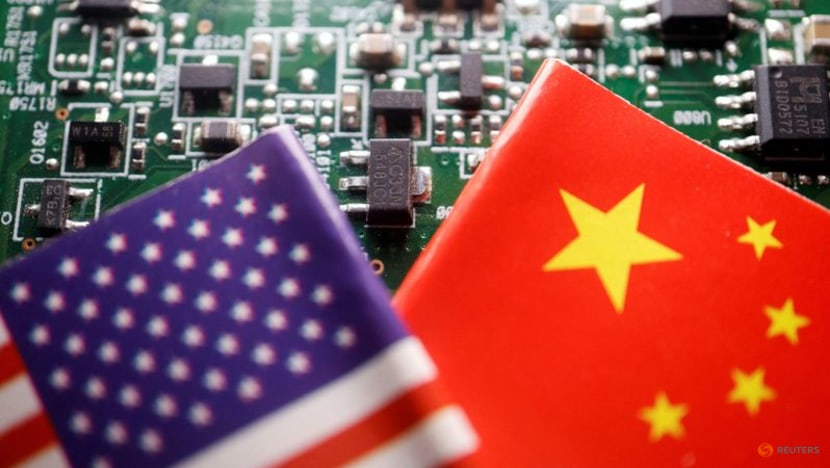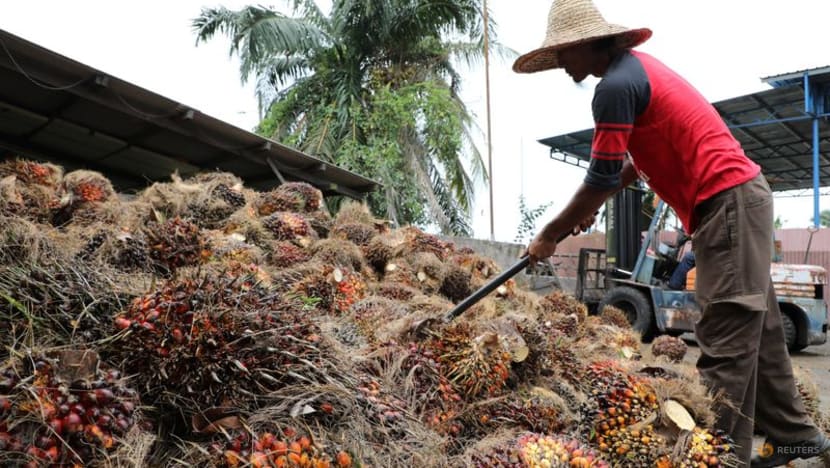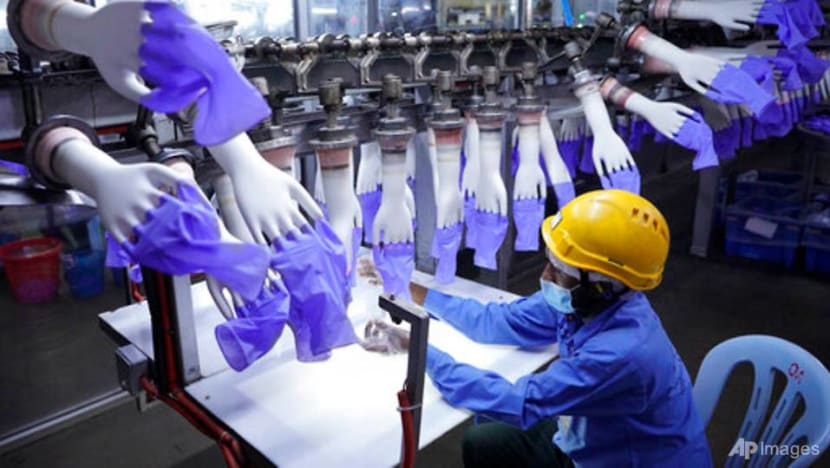‘Sanity will have to prevail’: Malaysia’s key exporters in limbo, fear but some hopeful over Trump's tariffs
KUALA LUMPUR/JOHOR BAHRU: Over the past week, employees at furniture factory KS Design in Muar have been working 16-hour shifts to fulfil orders from the United States.
In the wake of US President Donald Trump’s “Liberation Day” tariffs announced on Apr 2 and a 90-day pause announced on Apr 8, distributors in the States requested that KS Design manufacture and deliver outstanding shipments quickly before the taxes are imposed, said its owner Albert Ng.
“My company is rushing to produce … cupboards, dressers, all kinds of furniture … It's been a bit hectic. We don’t know when and how the tariffs will be (imposed), so better to fulfil the orders quickly,” Ng, 42, told CNA.
Malaysia is among dozens of countries hit with higher tariffs than Trump’s universal 10 percent tariff on all imported goods, with a 24 per cent tax imposed.
Factories in Muar, a furniture manufacturing hub in Malaysia, are taking advantage of the 90-day reprieve to finish up batches of orders before a higher rate kicks in.
Amid the scramble to fulfil short-term orders, however, Ng is apprehensive about when, and if, the tariff will be implemented. And when it comes into force, making goods from Malaysia more costly to import, he fears that orders from clients in the US will dry up.
“We are a bit concerned about the tariffs … we don't know how much (it will ultimately be) so (let’s) wait and see. Whatever it is, we are trying to fulfil our orders quickly before tariffs come,” he said.
The uncertainty has given rise to mixed sentiments among Malaysian businesses.
While some may currently be seeing a feast in orders from the US, businesses in the electronics and furniture sectors – which make up some of Malaysia’s biggest exports to the US – worry about whether a “trade famine” is coming and if it will force them to downsize or even shut operations.
Those in other sectors such as in rubber and palm oil are more sanguine about their prospects, cautiously optimistic that they could potentially benefit as the tariff imposed on these products from Malaysia may be lower than those for neighbouring countries like Cambodia, Vietnam and Indonesia.
“The 90-day reprieve, while offering short-term relief, creates a limbo that can be damaging for key Malaysian export industries like semiconductors, rubber and furniture,” said Malaysian Institute of Economic Research executive director Anthony Dass.
“While the reprieve avoids immediate damage, the uncertainty itself acts like a trade barrier. If not resolved quickly, it could erode confidence, push investments elsewhere, and lead to temporary job reductions in affected sectors,” he added.
Observers like Dass, as well as businesses, made some suggestions on how Malaysia could cope with the tariffs, even as they lauded the government’s efforts to continue negotiating with the US, including a proposed technology safeguard agreement to ensure that the products exported to the US comply with Washington’s requirements and regulations.
“NOT BUSINESS AS USUAL” FOR SEMICONDUCTOR FIRMS
Businesses in Malaysia are especially concerned about the Trump administration’s recent efforts to investigate imports of semiconductors and pharmaceuticals.
The investigation will reportedly be launched under Section 232 of the Trade Expansion Act of 1962, which allows the president to restrict imports deemed a threat to national security.
Some observers have said this could pave the way for tariffs to be imposed on the specialised products, setting the stage for more friction between US and Asian economies like Taiwan and Malaysia, which Washington heavily relies on for semiconductor chips.
In 2024, Malaysia shipped US$16.2 billion worth of chips to the US, accounting for nearly 20 per cent of all US semiconductor imports, according to US trade data. Meanwhile, around 44.2 per cent of US semiconductor imports are from Taiwan.

President of the Malaysia Semiconductor Industry Association Wong Siew Hai told CNA that firms in that sector are hoping for the best but planning for the worst.
“It’s not business as usual right now, because we are waiting to see how much … we get hit (in tariffs),” said Wong.
“If you hope for the best, it will be 10 per cent. But if you prepare for the worst, I guess it’s 24 per cent (similar to Malaysia’s reciprocal tariff rate) and hopefully not higher,” he added.
Wong said there was no halt in production of semiconductor chips being exported to the US presently, but acknowledged the uncertainty is not healthy for the sector.
The 90-day limbo will likely trigger spillover effects in the semiconductor supply chain, said business consultant Samuel Tan, who is also president of the Johor-Indonesia Business Chamber.
“Even with the 90-day reprieve, the environment of uncertainty is not good for the manufacturers. They will not be willing to buy parts for future production and this will disrupt the entire supply chain,” said Tan.
Semiconductor tariffs could be higher than the 24 per cent reciprocal tariffs slapped on Malaysia, trade expert Deborah Elms said.
Semiconductors and electronics are “at particular risk” as these are going to be subject to a different type of tariff regime, she said. “Even if reciprocal tariffs go away or get reduced, something similar is less likely for goods under Section 232.”
Besides semiconductors, Elms noted lumber is being considered for investigation under Section 232 and, by extension, this could impact furniture imports.
“Although I do not think this will capture furniture, the Trump team likes to take a very broad definition of a sector. (It’s something) worth watching (out for),” said Elms, who is head of trade policy at Hinrich Foundation and founder of the Asian Trade Centre.
According to figures published by Trading Economics, furniture accounted for around 3.6 per cent of all exports from Malaysia to the US in 2024 – the fifth-highest sector behind semiconductors, machinery, medical apparatus and rubber.
KS Design’s Ng said many Muar furniture manufacturers are concerned that timber and furniture could become a tariff category of their own.
“We are a bit concerned …. that timber could be included as a separate tariff and that it will be more than the 24 per cent (reciprocal tariff for Malaysia),” he said.
PALM OIL, RUBBER GLOVE COMPANIES COULD BENEFIT
Speaking at a press conference on Monday after the National Geoeconomic Action Council meeting, Minister of Investment, Trade and Industry Tengku Zafrul Abdul Aziz acknowledged there are some sectors of the economy which “could even benefit” from Trump’s tariffs.
He did not specify which sectors, but industry players and observers say rubber, palm oil and even semiconductors could gain. The caveat, however, is that US policies could rapidly change, making long-term predictions difficult.
Nivas Ragavan, vice-chairman of the Federation of Malaysian Business Associations (FMBA), told CNA that while the tariffs are not ideal, being subjected to a lower rate than regional neighbours offers Malaysia a competitive edge.
It could be incentive enough for certain US buyers and investors, particularly in sectors like manufacturing, electronics and medical supplies, to buy from Malaysia, he said.

“There’s a window of opportunity here for Malaysian exporters to step up, innovate and fill the gap left by regional competitors,” he said.
Semiconductor veteran Wong agreed that with more favourable tariff rates, Malaysian products could gain an edge over competitors such as China.
Trump has imposed a 125 per cent duty on Chinese imports on top of 20 per cent imposed earlier this year, bringing the cumulative rate to 145 per cent under the new administration. China in turn has hit back with a 125 per cent tariff on the US.
“If the tariffs are higher, they (importers) would have to look for a solution. And Malaysia could be their solution,” Wong said.
Similarly, the Malaysian Plastics Manufacturers Association (MPMA) said some of their members have seen a spike in business enquiries, although this might only be for the short term and are subject to future tariff announcements and outcomes of trade negotiations.
“This uncertainty is making businesses cautious about long-term strategies and investments,” said association president C C Cheah.
In the commodities sector, Malaysian producers could also fill the supply gaps left by countries facing steeper tariffs.
But it is not a given, said Malaysian Palm Oil Board (MPOB) director general Ahmad Parveez Ghulam Kadir.
While Indonesia, the world’s largest palm oil producer, faces comparatively higher US tariffs of 32 per cent, it could respond by diverting the commodity from the US to other markets, including those that Malaysia supplies, he noted.
“So finally it may be status quo,” he said. “The 90 days’ delay will give time for us to be more prepared for reducing potential negative effects, if any,” he said.

Malaysia is the second-largest palm oil producer and in 2024, its exports to the United States were worth RM889.97 million (US$202 million), accounting for about 10 per cent of US’ total palm oil imports, said Ahmad.
The US imports around 85 per cent of its palm oil from Indonesia.
“If there are any issues faced in any country we need to find a solution or start negotiating with the importing country,” said Ahmad Parveez. While the US is not a particularly big market for Malaysian palm oil, it is nonetheless important, he said.
Rubber exports, especially gloves, are another sector that some have predicted could benefit from high US tariffs against China.
According to the Malaysian Rubber Council, Malaysia's rubber product exports to the US reached RM7.923 billion last year, constituting one-third of the nation's total rubber product exports.
Gloves made up approximately two-thirds of Malaysia’s rubber exports overall.
Malaysia’s Top Glove, the world's largest manufacturer of gloves, reportedly said it is anticipating increased volumes due to relatively favourable tariff rates.
“As the US accounts for about 25 per cent of Top Glove’s global export sales, we believe this will generally be positive for the company. However, as these are early developments, we will continue to monitor the situation and assess the full impact of the tariffs in the coming months,” the company was quoted as saying by business portal The Edge.

The Malaysian Rubber Glove Manufacturers Association (MARGMA) is cautious. Its members are seasoned exporters and have been doing their best to prepare for the tariffs, president Oon Kim Hung said.
“Essentially, anything to do with tariffs is negative. There will undoubtedly be an impact on exporters, including the glove sector. As long as there is a degree of certainty about what lies ahead, we will be able to overcome it,” he said.
“The impacts of this tariff are still unfolding, and we are closely monitoring the effects on our industry and on businesses,” he added.
So far, none of the association’s members, which include Top Glove, has been adversely affected and exports are proceeding normally, he said.
In 2024, the US was the largest export market for Malaysia’s rubber glove makers, accounting for 41 percent of their exports. Europe and Asia accounted for 28 per cent and 21 per cent, respectively.
“We are expanding our market to Africa and hopefully the consumption rate will go up. We are trying to diversify our markets as well from the US because it is a very competitive market,” said Oon.
Although competitors such as China face higher tariffs and Malaysian rubber gloves could gain more market share, Oon said tariffs are “always negative”.
He also said that it will be difficult for any businesses to keep up with policies that keep changing.
"We have got to stay viable, as sanity will have to prevail and businesses will have to carry on. I believe our members are able to navigate and manage through the confusion and impact of this new US tariff,” he said.
Some exporters told CNA that US customers have tried to negotiate for discounts in the wake of Trump’s announcements to maintain their profit levels.
“My buyer complained about the tariffs but I have made it clear that there would be no change to the prices. If their government imposed additional tariffs, we are not going to be responsible,” said Ruseta Tajuddin, the chief financial officer of Fikrisz Sdn Bhd, which supplies 18 brands of coffee powder to the US.

Adding that the company’s competitors are from China, she told CNA: “The buyer will have to bear that pressure and increase his selling price to his customers. He will be able to explain it to them.
“I have given a very good price to them and even without the tariffs they are selling it for a big profit. So I don’t think there will be much of an issue.”
The US accounts for about 65 per cent of the company’s exports while Saudi Arabia is its next biggest market at about 20 per cent.
Ruseta said that the company has been exporting its products to the US for 21 years now.
One of Fikrisz’s shipments was, in fact, nearing the US when Trump announced the reciprocal tariffs on April 2, catching her buyer by surprise.
The chief executive of another Malaysian foodstuff company who only wanted to be known as Kim told CNA that her firm faced discount requests from their US distributors after the tariffs were announced.
She decided to offer a slight discount to new distributors as an incentive to get them on board.
“The US market is one of the most challenging markets to enter because the distributor expects you to build the brand and contribute in terms of marketing,” she said, adding that other countries do not request as much in terms of marketing support.
The company, which exports to more than 10 countries around the world, entered the US market in 2023. The US makes up 5 per cent of her company’s exports and Kim said she is not overly worried due to its diversified markets.
“Since our product is more of a lifestyle purchase, customers might be less motivated to buy it,” she said. “But our product isn't very expensive to start with, so hopefully, the price rise won't be so significant that people stop buying it altogether.”
HOW CAN MALAYSIA HELP ITS BUSINESSES?
While Malaysian exporters could see mixed fortunes, industry leaders are hopeful about their government’s negotiations with Washington.
Economists also lauded the government’s move to offer a technology safeguard agreement.
On Monday, Tengku Zafrul said this proposal would allay concerns the US could have on the “security of technology” produced in Malaysia.
He added that Malaysia’s trade representatives have also approached their counterparts in the US for a meeting, but have not received a reply on a possible date.
“We will need to have a comprehensive strategy but (at the same time) we need to know our red line (negotiation threshold),” said Tengku Zafrul.
Tan, the business consultant, told CNA the technology safeguard agreement is a way to reassure Washington that Malaysia is not used by countries with higher tariff rates to channel exports to the US.
He noted that Malaysia has been under scrutiny amid investigations on shipments of Nvidia artificial intelligence chips allegedly supplied fraudulently from Singapore to China via Malaysia.
“Steps to enhance surveillance to prevent fraudulent declarations of product origin are very important. There must be a high level of confidence from importing countries that there are regulatory frameworks to ensure compliance and transparency in Malaysia,” he added.
Wong told CNA he was not aware what this agreement would entail as many semiconductor firms in Malaysia already comply with US restrictions.
“We are already subjected to a few conditions and we cannot circumvent them - this includes restrictions (on) the use of any Chinese equipment and materials. Maybe the technology agreement would impose more conditions … we are ready to comply,” he said.
Overall, it is key for Malaysia to “win the heart of the US officials” and make the point that Malaysian semiconductor companies have been a major supplier for “more than 50 years”, he said.
“I started in 1976 and I’ve seen the whole history – how we supported the US’ growth through its good times in ‘super growth’ and ‘hyper growth’, as well as bad times, through whatever recessions. We have gone through the whole works and delivered everything,” said Wong.
“I think that counts for something.”
The Malaysia government can also expand export markets to help firms diversify risk, observers said.
The government could speed up its exploration of markets in Africa, Latin America, Central Asia and the Middle East, said Nivas of the FMBA, who called on the Malaysia External Trade Development Corporation to work with private sector partners to fast-track new trade corridors and reduce dependency on traditional Western markets.
Ahmad of MPOB also emphasised the importance of finding new markets, saying that diversification is about mitigating risks.
“We have stable markets, as we export to more than 150 countries. We just need to maintain and maybe strengthen the existing markets. At the same time wherever possible, we should explore new markets,” he said.
Disclaimer: Investing carries risk. This is not financial advice. The above content should not be regarded as an offer, recommendation, or solicitation on acquiring or disposing of any financial products, any associated discussions, comments, or posts by author or other users should not be considered as such either. It is solely for general information purpose only, which does not consider your own investment objectives, financial situations or needs. TTM assumes no responsibility or warranty for the accuracy and completeness of the information, investors should do their own research and may seek professional advice before investing.
Most Discussed
- 1
- 2
- 3
- 4
- 5
- 6
- 7
- 8
- 9
- 10